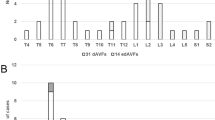Abstract
Considering surgical treatment of spinal dural arteriovenous fistulas, the major difficulty is to localize them reliably during surgery. Usually the affected spinal level is sought by counting of bony structures using fluoroscopy. However, quite frequently, anatomical particularities impede adequate counting resulting in surgery performed at erroneous spinal levels. The objective of this study was therefore to evaluate the potential benefits of preoperative coil marking in order to facilitate intraoperative localization of spinal dural arteriovenous fistulas. After detection of the fistula with spinal angiography, selective catheterization of the feeding vessel was performed, and a GDC coil was detached in the lumen of the vessel adjacent to the respective bony pedicle. Coil marking was effected in 8 patients (group A), 20 patients were operated without such a marking (group B). The data of both groups of patients were compared with regard to accurateness of the surgical approach, duration of surgery, and dosage of intraoperative fluoroscopy. In all patients of group A, the coil was easily identified by intraoperative fluoroscopy. A partial hemilaminectomy was sufficient for localization and microsurgical treatment of the spinal dural arteriovenous fistula in each patient. In patients of group B, the correct spinal level was approached in 12 patients (60%), in 8 patients (40%) surgery was performed initially at an erroneous level (P = 0.048). Mean duration of surgery was 130 min in group A and 177 min in group B (P = 0.031). Likewise, mean dosage of intraoperative fluoroscopy was higher in group B (119.5 vs. 394.3 cGy/cm2; P = 0.036). Preoperative coil marking allows exact intraoperative localization of spinal dural arteriovenous fistulas. Thus, surgery at erroneous spinal levels is avoided, and it is feasible to perform a straightforward, minimally invasive surgical approach. This reflects in significant reduction of duration of anesthesia and surgery. Moreover, radiation exposure of the patient is significantly reduced.


Similar content being viewed by others
References
Birchall D, Hughes DG, West CG (2000) Recanalisation of spinal dural arteriovenous fistula after successful embolisation. J Neurol Neurosurg Psychiatry 68:792–793. doi:10.1136/jnnp.68.6.792
Britz GW, Lazar D, Eskridge J, Winn HR (2004) Accurate intraoperative localization of spinal dural arteriovenous fistulae with embolization coil: technical note. Neurosurgery 55:252–255. doi:10.1227/01.NEU.0000127883.26964.81
Eskandar EN, Borges LF, Budzik RF Jr, Putman CM, Ogilvy CS (2002) Spinal dural arteriovenous fistulas: experience with endovascular and surgical therapy. J Neurosurg 96:162–167
Hassler W (2007) Personal communication
Huffmann BC, Gilsbach JM, Thron A (1995) Spinal dural arteriovenous fistulas: a plea for neurosurgical treatment. Acta Neurochir (Wien) 135:44–51. doi:10.1007/BF02307413
Koch C (2006) Spinal dural arteriovenous fistula. Curr Opin Neurol 19:69–75. doi:10.1097/01.wco.0000200547.22292.11
Schaat TJ, Salzman KL, Stevens EA (2002) Sacral origin of a spinal dural arteriovenous fistula: case report and review. Spine 27:893–897. doi:10.1097/00007632-200204150-00023
Steinmetz MP, Chow MM, Krishnaney AA, Andrews-Hinders D, Benzel EC, Masaryk TJ, Mayberg MR, Rasmussen PA (2004) Outcome after the treatment of spinal dural arteriovenous fistulae: a contemporary single-institution series and meta-analysis. Neurosurgery 55:77–87. doi:10.1227/01.NEU.0000126878.95006.0F
Author information
Authors and Affiliations
Corresponding author
Rights and permissions
About this article
Cite this article
Marquardt, G., Berkefeld, J., Seifert, V. et al. Preoperative coil marking to facilitate intraoperative localization of spinal dural arteriovenous fistulas. Eur Spine J 18, 1117–1120 (2009). https://doi.org/10.1007/s00586-009-0946-4
Received:
Revised:
Accepted:
Published:
Issue Date:
DOI: https://doi.org/10.1007/s00586-009-0946-4




